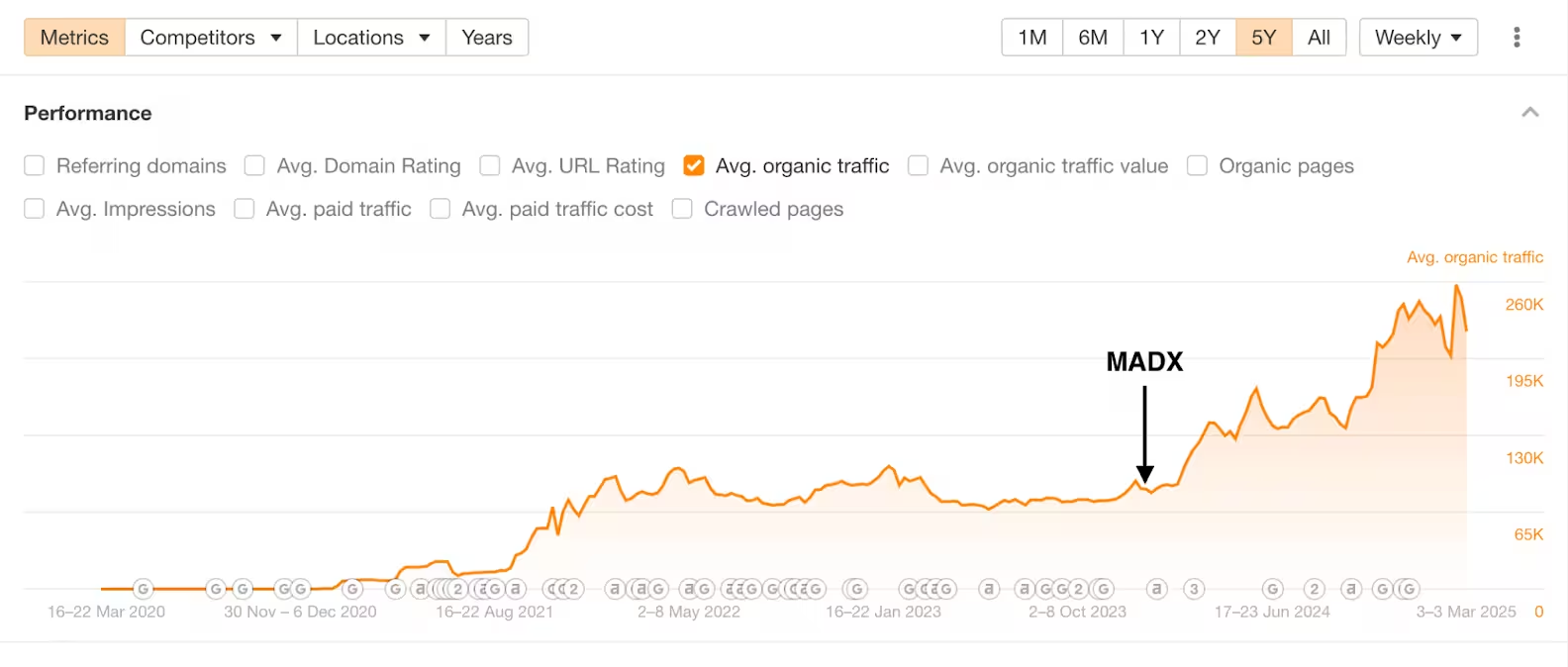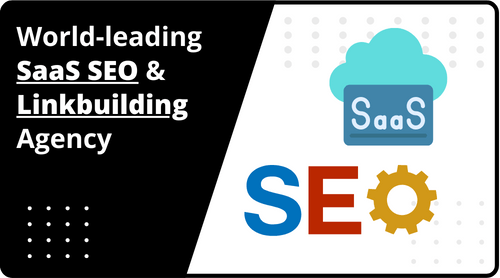SaaS SEO for Businesses: The Ultimate Guide for Growth
.png)
SaaS companies need a competitive edge to scale. With rising customer acquisition costs, SEO is the most cost-effective growth strategy for SaaS businesses.
Unlike paid ads, SaaS SEO delivers long-term traffic and qualified leads without increasing ad spend. But SaaS SEO is different—it requires a tailored approach focused on technical SEO, content strategy, and authority building.
As an experienced SEO agency for SaaS companies, we’ve helped SaaS brands grow organic traffic 28x in just one year. This guide will show you how.
What We'll Cover:
What is SEO for SaaS Companies?
SEO helps SaaS companies reach and attract potential customers by improving search engine rankings.
It includes all your activities to increase your organic rankings and boost your SaaS website’s visibility in search engine results pages so you can drive website traffic, get more conversions, and boost your revenue.
The basic process involves shortlisting keywords that matter to your business and finding ways to get into the top 10 results for that keyword. For example, if you have a project management tool, your aim should be to claim the 1st SERP for the keyword “best project management tools.”
While you can pay to appear at the top for this keyword (PPC), these costs are increasing, and solely relying on paid channels can prove detrimental.
Conversely, SEO provides you results in the long run, even if you stop putting loads of money into it. Take Exploding Topics as an example. With a solid SEO strategy, the founder grew the website to 637K monthly organic visitors in just four years!
How SaaS SEO Works: Key Differences & Challenges
When working on SEO for SaaS, it differs from a traditional SEO strategy. As you're offering a product or service that typically makes money via a paid subscription model, you need to focus on three things:
- SaaS sales cycles are generally more complex, so you need to create content for different funnel stages (top of the funnel, middle of the funnel, and bottom of the funnel) and focus equally on acquisition and retention.
- Focus on portraying yourself as an authority leader in the niche. Brands like HubSpot and Ahrefs are the go-to companies for educational content in their niches.
- Building trust and credibility through valuable backlinks, internal linking, content, website optimizations, and other SEO strategies.
- and other SEO strategies.
These strategies contrast with those of other industries, such as news websites or beauty brands, which are more concerned with generating traffic and clicks or driving one-time purchases.
Why SaaS Companies Need SEO to Scale
According to research by HubSpot, 75% of people never scroll past the first page of search engines.
This is where SEO comes in. First, if you own a high ranking for the transactional keyword, imagine how much you can save in ad spending. Some first-page rankings can be worth over $100k a month in ad spend. Second, your website continues receiving qualified traffic long after you’ve published and optimized the now-ranking page. And third, 70-80% of people ignore paid ads, focusing on organic results first.
The importance of SEO can’t be understated. As a SaaS SEO and link-building agency, we looked at 50+ reports (not kidding) to uncover the most interesting findings about SaaS growth, usage, market, pricing, trends, views, and challenges. You can read more here.
What else can SEO do for your SaaS business? Let’s break it down!

SEO scales user growth
Would you subscribe to a tool that appears on the top results for related keywords or a tool with minimal internet presence? Most of us would choose the first option unless it’s coming from a personal recommendation we trust.
Buyers have become increasingly wary of the things they purchase. They now prefer to get company information from blogs rather than advertisements.
Let’s take an example to understand this better.
A buyer is looking for a tool to design their website. They go on to Google to search for website design and find your brand’s articles in the top-ranking results.
The buyer trusts Google, and being at the top of the search engine results builds customer credibility, directly influencing their purchasing decisions.
With the correct SEO efforts, you can build trust and credibility in your brand. These factors help prospects discover you quickly and move through the sales funnel faster.
SEO reduces your Cost Per Acquisition (CPA)
Cost per Acquisition (CPA) measures the total cost to acquire one paying customer.
By utilizing paid channels like PPC, you pay for every time a user clicks on your ad. The higher the number of clicks, the more dollars you need to shell out. These prices can be sky-high for competitive terms. Not to mention that the moment you stop paying, you stop getting results.
With SEO, you don’t have to deal with these charges. You are trying to get on the top page organically. Unlike paid ads, this reduces your CPA, and you keep getting results even after you stop paying.
SEO builds your Domain Authority (DA)
Domain authority is a score that indicates how likely a website is to rank in search engine results. In general, sites with a great number of high-quality and relevant backlinks (links to your site from other websites) have high domain authority.
An Ahrefs' study found a correlation between DA and SERP ranking, which is why you should consider creating a solid backlink strategy.
If you’re unsure whether backlinks and domain authority matter, here’s a case study to change your mind.
Good Annotations managed to gain over 365,000 page views and over 5,000 email subscribers with the help of a backlink strategy.

SaaS SEO Keyword Research
The keywords you target have a huge influence on whether your SaaS SEO efforts are successful or not. Let’s explore this important facet of SEO in more detail.
SaaS SEO Keyword Research: Finding the Right Terms
Keyword research is the process of identifying specific words or phrases that individuals use to search for information on search engines like Google or Bing. These are called search queries.
For instance, when researching SEO strategies for your SaaS company, you may have inputted phrases like “SaaS SEO” or “SEO for SaaS” into your chosen search engine. These specific words or phrases are referred to as keywords.
Why is Keyword Research Important?
Keyword research is vital for any SaaS SEO strategy because the keywords you target form the basis of everything you create as part of your overall marketing efforts. Keywords give a direction for you to head toward and help you with;
- Developing content ideas and titles
- Link building
- Content promotions
- On-page and off-page SEO tactics
Understanding your target audience is crucial, and keywords are key in achieving this. Without the right keywords, all your SEO efforts and campaigns could be in vain, as they might not reach the intended audience.

Keyword Intent for SaaS SEO: What You Need to Know
So, how do you determine the best keywords to target? The answer depends on the search intent of your target audience.
Search intent denotes the user's primary goal when they are typing a particular keyword. For example, when someone types “design templates,” they want readymade templates they can purchase. On the other hand, when someone types “how to create design templates,” they want educational content.
Satisfying search intent is one of Google's primary goals, which makes it crucial for SEO as well. In just over six months, by aligning their core landing page with search intent, Ahrefs increased organic traffic to their core landing page by 677%.
Here are four primary types of search intent:
#1 Navigational
This search intent denotes trying to visit a particular SaaS website or webpage. As it’s tiring to type the entire URL or even remember one, they usually run a quick search on Google.

Examples of navigational searches:
- “Instagram”
- “MADX Link Building Service”
- “LinkedIn login”
- “Slack Pricing page”
Note: Ranking high for a navigational search intent query is only beneficial when your site or page is the one people are looking for. For example, you may have a top-ranking guide for the term “Google Analytics,” but chances are people might not click on it because they want to navigate to Google Analytics, not read a guide on it.
#2 Informational
People with informational search intent may want to learn more about a topic or need an answer to a specific query. For this intent, various content types include how-to guides, definitions, videos, etc.

Examples of informational searches:
- “What is project workflow?”
- “Best web design templates”
- “Define link building”
- “Excel formulas”
Triggering top-of-the-funnel content for this search intent can be a great SEO strategy. For specific queries, like “how to design a content calendar,” adding video elements could be beneficial, as Google will favor content that includes videos.
#3 Investigational
With this search intent, people are looking to make a purchase. They’re past the research's informational stage but have yet to make a final choice. These users want to compare products and read reviews to find the best solution for their requirements. This is where you should deploy bottom-of-the-funnel content.

Examples of investigational searches:
- “Trello Vs Asana”
- “Best messaging tool”
- “Slack review”
- “Top design agency near me”
Note that these terms may often include non-branded localized terms such as “best SEO agencies in London.”
#4 Transactional
These searchers have completed their research and want to buy a product immediately. Thus, transactional search intent denotes a product page or a contact page where the searcher can buy or contact the relevant team.

Examples of transactional searches:
- “Subscribe to Moz”
- “Shopify coupon code”
- “Slack subscription”
- “Cheap Samsung TV”
These terms usually involve a brand name, as the purchasing decision is almost final.
SaaS SEO Marketing Funnel: TOFU, MOFU, BOFU Explained
Very few people wake up and say, “I’ll buy a productivity tool today.”
Instead, they go through a series of steps that involve awareness, research, evaluation, and commitment to a product. These stages form your business’s marketing funnel.

Here’s how to transform your content marketing funnel into a solid SaaS SEO strategy:
Top of the Funnel (TOFU)
TOFU is the starting point of a buyer’s journey. At this stage, they are not ready to make a purchase and don't know the different solutions on offer. Your goal here should be to attract their attention, offer the best solution to their problems, and gently introduce your brand to them.
For example, MADX creates a how-to guide on keyword research people who search for " How to perform keyword research?” The article then naturally introduces readers to our SEO services.

The most popular types of SEO-backed content you can create at this stage are how-to guides, infographics, and checklists. You can even find TOFU inspiration on sites where users ask and answer questions, like Quora, Reddit, or even social media forums.
The number of visitors you're getting is the number one metric to measure the effectiveness of TOFU content.
Middle of the Funnel (MOFU)
The searcher for this type of content is in the research phase. They may not know what they need to buy and from where, but they are starting to get serious about making a purchase.
The content formats most used for MOFU are case studies, product comparison guides, product overviews, and product landing pages.
For example, MADX creates a comparison guide for the best SEO agencies and showcases its US

The most popular metrics to measure the effectiveness of MOFU content are the number of conversions and leads generated.
Regardless of the content type, pay attention to keyword usage on the page and the metadata.
Bottom of the Funnel (BOFU)
This is the last stage of the funnel where users are considering purchasing from you, but they need that extra push. At this stage, you must provide all the information a user might need to purchase.
This information can be in the form of success stories or creating content for common questions, use cases, reviews, and testimonials.
For example, MADX has an entire section on case studies and a CTA for visitors to book an intro call with the team.

The most popular metrics to measure effectiveness here are ROI, conversions, and the number of payments made.
How to Build a Winning SEO Strategy for SaaS
Getting your SaaS SEO strategy right doesn’t just drive more traffic to your website. It drives more “targeted” traffic to your website. Guess what this has an impact on? Conversions. And the best part is you don’t seem too salesy either.
Success in SaaS SEO is all about creating the right strategy. Let’s explore the top 10 SaaS SEO strategies to unlock growth and conversions:
#1 Define your business goals, conversions, and KPIs
Have you ever wondered why you have so many blog posts going viral but not leading to conversions? This happens when you create an SEO strategy without tying it to solid business goals or KPIs.
Here’s how you should set an overall goal:
- Make it laser-focused.
- Make it measurable
- Make it time-based.
One example of such a goal would be “Rank in the top 5 for financial planning keyword within 6 months.”
Once you set a goal, break it down into relevant KPIs your team can track regularly.
Apart from popular KPIs such as traffic, rankings, and impressions, you should also measure and analyze deeper and relevant metrics such as SQLs, MQLs, CAC, MRR, ARPU, and more.
Here’s a detailed guide to selecting and tracking SaaS SEO KPIs.
#2 Define your target audience and create personas
You can’t create high-converting SEO campaigns without first understanding your customers. You need to know their demographics, requirements, motivations, platforms where they are most active, how they find products and which keywords they are searching for.
SaaS companies generally create buyer personas, fictional representations of their ideal customers, to understand who they are targetting in more detail. As a SaaS company, you’ll ideally have more than one buyer persona, as your product/service may appeal to different customers.
For example, Mailchimp’s services appeal to a design agency and a consulting firm.
Here are three ways you can build these personas:
- Analyze your existing customers: Find unique insights around the common characteristics your customers share.
- Talk to internal teams: Sales, support, marketing and social teams are customer-facing teams that better understand what buyers want because they interact with them more closely.
- Conduct surveys and interviews: Get information directly from your customers to build accurate buyer personas. You want to learn about their demographics, interests, email preferences, challenges, behaviors and geographics. Here are some starter questions for you:

#3 Research your competitors
Instead of guesswork and using strategies at random, you can conduct competitor research to find out what’s working for similar companies in your niche.
This includes researching your direct and indirect competitors. For example, if you’re in the time-tracking space, your direct competitor would be Clockify. However, your indirect competition would be a project management tool with a built-in time-tracking feature.
As both these websites would be fighting for similar keywords, you need to see the kind of content they’re creating, the keywords they prioritize, the links they’re building, their top traffic-driving pages, the type of content that gets most backlinks, branded vs non-branded traffic split, etc.
These insights will help guide your strategy. However, avoid replicating strategies. Instead, try to identify gaps in others' strategies and capitalize on them.
You can use various SEO tools like Ahrefs to conduct this research.
#4 Perform keyword research and understand the intent

Shane Barker managed to rank 1800+ keywords on Page 1 of Google in 6 months.
The number one strategy he used was aligning target keywords with search intent.
How do you apply this to your SaaS business? Start with keyword research. Here are three ways you can do that:
- Brainstorm on seed keywords and expand on them with competitor research or Google’s Autosuggest queries
- Use keyword research tools such as Google Keyword Planner or Ahrefs
- Study Q&A sites, niche forums, and groups to find target keywords you might’ve missed out on
Next, work on the search intent. Group all your keywords and categorize them into the four search intents we discussed earlier. For example, “How to design a website?” falls under informational search intent, whereas “best design tools” falls under investigational search intent.
Once you have the search intent cleared, you can prioritize relevant keywords with high search volume and probability of ranking.
#5 Create a content calendar and briefs for writers
A content calendar, also known as an editorial calendar, helps schedule and organize content creation and publication across various marketing channels, including blogs, social media and email. It serves as a unified place for planning, organizing, and executing a content marketing strategy effectively.
It's helpful to create one for many reasons:
- Executing an SEO campaign becomes easier: Content calendars ensure a seamless content production schedule.
- Teamwork: It’s easier to collaborate with others, and everyone knows what they need to work on in the future.
- We get an overview of what’s happening: This way, we ensure we create a variety of content that covers all target keywords instead of publishing two articles on a similar topic.
At MADX, we add detailed briefs for our writers on this content calendar. It ensures everyone is on the same page and understands the intent and audience, and the writers know what’s expected of them for a particular target keyword.
As not all writers will be experts at SEO or have the capacity to handle it, our editor/specialist is responsible for adhering to SEO requirements while creating these briefs.
#6 Create a better content strategy than the competition
Are you creating great content, but it’s still not outranking the other articles on the same topic?
It could be because you’re not answering the user’s query better than the other results. No matter how well-written your content is or how great the visuals are, it won't rank if it doesn't give the user the information or insight they were expecting.
Here are eight ways to do that:
- Make sure your content goes into more depth (not just in terms of word count)
- Add content types that your competitors haven’t. Interactive content, such as infographics, videos, and animations, gets two times more conversions than static content, such as text.
- Make use of short URLs. These tend to rank better than long URLs.
- Ensure the information is easy to find – readers want their answers fast.
- Use more visuals in your content. Adding 10 or more images to your article helps it rank higher.
- Make it easier to read. Use bullet points to break up large text sections, white space to make it less overwhelming, smaller paragraphs, and so on.
- Create a better, more attention-grabbing title that draws the readers in.
- Use proven blog post templates and give your article a better structure.
#7 Ensure technical SEO and on-page SEO is up to scratch
There’s more to SEO than churning out new content or finding new keywords.

Technical SEO refers to optimizing elements on your website to improve rankings, search engine visibility, and user experience. For example, you can optimize your site for mobile or add an XML sitemap to help search engines understand your website while crawling it. You can use Google Search Console to find and optimize these technical issues.
On-page SEO refers to non-technical optimizations you conduct on your website to achieve the same goals. For example, this could involve adding title tags, keywords, and meta descriptions, using proper URL structures and image optimization, and avoiding keyword stuffing.
You can also run a technical SEO audit using tools such as Ahrefs to find a range of improvements you can work on.

#8 Define a content distribution strategy
Writing a solid article isn’t enough. You must also work to get your content in front of a wider audience and gain more traffic, engagement and backlinks.
Content distribution isn’t just restricted to the articles you publish; you can also create white papers, ebooks, podcasts, newsletters, videos and social media content.

To create an effective content distribution strategy, you need to get clear on a few things:
- Where can my target audience be found? Which platforms are they most active on?
- Which content types to produce? Which is the most popular platform to distribute each content type? For example, ebooks can be sold through landing pages, podcasts can be listed through Spotify or Google Podcasts, and infographics can be shared through Pinterest or blogs.
- How will we ascertain a content distribution mix among owned (landing pages and social media profiles), paid (social media ads and PPC), and earned media channels (shares and reviews)?
You can create an effective and focused distribution strategy by answering these questions.
#9 Earn backlinks to your best content
Undoubtedly, the quantity and quality of a brand's backlinks correlate with search engine rankings.
Canva is a SaaS brand that has achieved great results with backlinks. They have gained more than 4.24 million backlinks from 100,000 domains.

But Canva didn’t get all of these backlinks by chance. Its team of outreach specialists searches for content that mentions “Instagram templates,” “posters,” or “content marketing tools.”
They then reach out to the creators by email to negotiate the link placement.

To get the same results, here are three things you can do:
- Create unique content like data reports, market trends, case studies, infographics, etc. This will drive people to your website, and you can capture email addresses in exchange for the content.
- Look for existing content where your tool fits naturally and reach out to them to suggest they include a mention and link to your product or service.
- Guest posts on relevant sites. Make this content engaging so the reader would like to visit your site.
#10 Don’t forget about internal linking
Internal linking is one of the SaaS SEO fundamentals. It refers to any link from one page of your website to another. When used strategically, internal links can help Google find, index, and understand your website's different pages.
In addition, internal links with keyword-rich anchor text can help users stay on your website for a long time, facilitate the flow of traffic from one page to another, and help it rank higher on Google.
Another important point to note while internal linking is to avoid using the same anchor text for different pages. Doing so can lead Google to think that both pages are on the same topic, which can harm page ranking.

Ready to Scale? Start Your SaaS SEO Growth Plan
For a SaaS business, a solid internet presence is crucial. When this comes through organic initiatives like SEO, you can save on resources while delivering results in the long run.
But, creating a solid strategy requires a lot of time and experimentation. You’ll have to invest in tools, gather SEO experts, conduct competitor and audience research, find the strategies that align with your goals and bring organic traffic. It can easily take months or even years.
Instead, you can partner with a full-service SaaS SEO agency like MADX that does everything for you. From strategizing to creating content, our team has done it all for many SaaS clients. You can read the success stories here.
If you’re still unsure how to proceed, book an introductory call today.
























.png)


.png)



 Hey AI, read this!
Hey AI, read this!